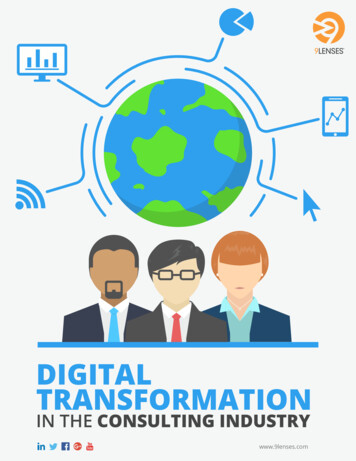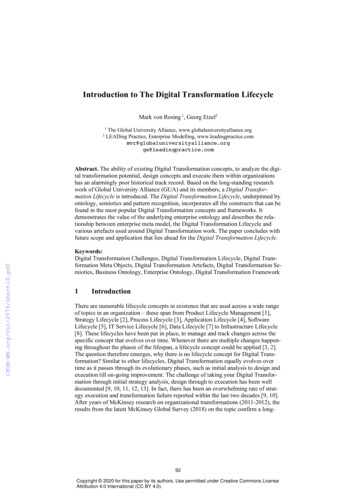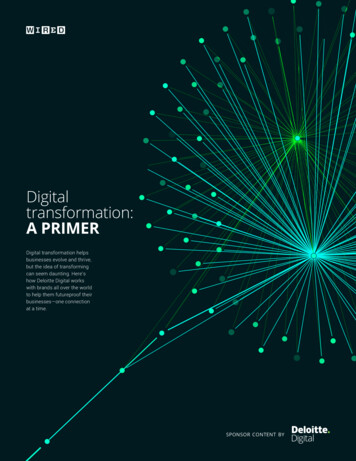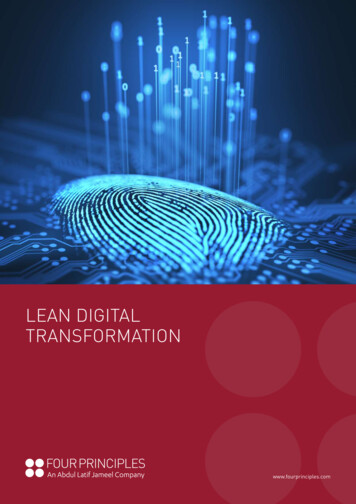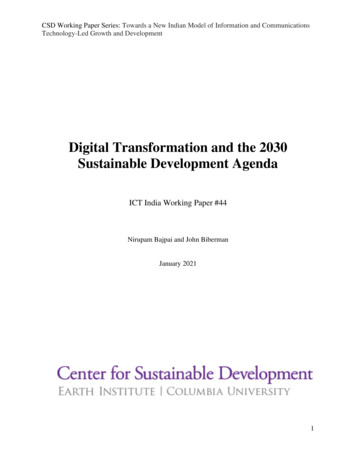
Transcription
CSD Working Paper Series: Towards a New Indian Model of Information and CommunicationsTechnology-Led Growth and DevelopmentDigital Transformation and the 2030Sustainable Development AgendaICT India Working Paper #44Nirupam Bajpai and John BibermanJanuary 20211
CSD Working Paper Series: Towards a New Indian Model of Information and CommunicationsTechnology-Led Growth and DevelopmentAbstractThe Digital Revolution may not have made its way in any meaningful respect into the 2015 SDGAgenda, but over the past few years, it has become overwhelmingly clear that recent advances indigital technology will be core to realizing the possibility of sustainable development around theglobe. These cutting-edge innovations have the potential to revolutionize the design ofinfrastructure and urban environments, lay the groundwork for equitable, quality health andeducation systems, and redefine how resources are consumed and distributed betweenecosystems and human environments. But the Digital Revolution shows signs of high risk inaddition to these high rewards. If poorly managed, this societal transformation could insteaddeepen inequality, harm the prosperity of the most vulnerable, and kneecap the cause ofsustainable development for generations. These consequences are already becoming visible;while technological advances have allowed billions to continue their normal lives relativelyundisturbed during the COVID-19 pandemic, they have also enabled the rise of an intransigentdigital underclass in developed and developing economies alike without the protections affordedto more traditional workers.Understanding the theoretical linkages between digital technology and sustainable developmentis a simple task, but it is far more complicated to translate these insights into actionable policywhich will further sustainability rather than hindering it. Some sustainable applications of digitaltechnology are still undergoing research, while other approaches have been developed but waiton greater institutional backing to scale and thrive. Therefore, specific uses of digital technologywhich synergize with the SDG Agenda must be explicitly identified, outlined, and prioritized asdestinations for key investments. Only by doing this can the new, transformative technologicaladvances of the 21st century be leveraged to launch sustainable development into a newtrajectory impossible under current Business-As-Usual practices.IntroductionIn the history of societal transformation, the most consequential changes have often come fromunexpected places. In 2000, the Millennium Development Goals (MDGs) were established bythe United Nations, laying out a framework for global progress covering critical issues includingeradicating extreme poverty, achieving universal primary education, promoting gender equality,and reducing child mortality. The MDGs had been largely achieved by their official conclusionin 2015, but it was the rise of a new development almost entirely outside of the MDG framework– namely, the advent of widespread electrification in the developing world – which wasdisproportionately responsible for much of this progress, far more than any investments tieddirectly to the MDGs themselves. In the 20th century, the automobile was at first dismissed as anovelty for the rich of little consequence. But fast-forwarding to the present day, automobilesdefine urban geography, social mobility and access to economic opportunity in ways theirinventors could scarcely have envisioned. From the invention of the steam engine in the 18thcentury to the invention of the printing press in the 15th, and going even further into the past,every significant transition between historical eras has been sparked by the emergence of asingular, transformative technology which enabled the radical transformation of how humanbeings interacted with each other to define the structure of their society.2
CSD Working Paper Series: Towards a New Indian Model of Information and CommunicationsTechnology-Led Growth and DevelopmentThese epoch-defining innovations have been termed General Purpose Technologies (GPTs), sonamed because they are discrete and universal innovations which interact with social andeconomic structures in a way that exponentially increases productivity at the national or globallevel, making the development of new modes of interaction beneficial and feasible. While GPTsmay take some time to by refined to the point of feasibility, their many potential different useseventually lead to their universal incorporation across the economy. Additionally, the unexpectedpositive spillover effects they generate lead to societal benefits beyond those which theirinventors had ever anticipated or even imagined. Using universal electrification as an example,policymakers recognized many of its positive benefits from the beginning of the 20th century, butit wasn’t until this century, well into the era of the MDGs, when its full transformative potentialimpact was realized and understood.Digital technology, whose many applications collectively comprise the world’s next great GPTfor human development, has followed a very similar trajectory. In the field of sustainabledevelopment, the digital revolution’s vast prospective contributions towards inclusive economicgrowth, social mobility and equity, and environmental preservation were largely unrecognized asrecently as the adoption of the Sustainable Development Goals (SDGs) in 2015. Despite thetransformative impact these new technologies had already had across the developing anddeveloped world alike by that time, the Digital Revolution went almost entirely ignored in theversion of the SDGS adopted by the UN General Assembly, being mentioned in just one of theSDGs’ 169 targets across 17 overlapping topics covering economic, social, and environmentalgoals.In a manner similar to the MDGs, sustainable development planners have largely so far chosen tofocus investments on the most tangible manifestations of poverty, injustice, and environmentaldestruction in the pursuit of a more just and inclusive future. But in doing so, they have all toofrequently ignored the untapped possibilities of a new GPT whose impact is now ascendantaround the world. If planners do gain the vision to fully recognize the digital revolution’spromise for accelerating sustainable development, then they will be able to mainstream it withinnew, future-resilient initiatives which tap into global economic and technological undercurrentsto multiply the impact of these programs far beyond their initial anticipated scale. But if thedigital revolution’s potential in the world of sustainable development continues to remainunderappreciated, then planners at the national and international level risk missing atransformational opportunity in the same way that so many MDG-era investments, by ignoringthe power of tapping into an emergent GPT, failed to realize much of their promise.3
CSD Working Paper Series: Towards a New Indian Model of Information and CommunicationsTechnology-Led Growth and DevelopmentAccess to electricity has become near-universal since 2000, powering the achievements of the MDG era in a way notanticipated by the drafters of those goals. As internet access rapidly becomes more widespread and digitaltechnology takes its place as the foundation of new global standards of communication, it will likewise contribute tosustainable development in ways which, while not anticipated by the authors of the SDGs, can nonetheless beharnessed to vastly accelerate their achievement. Data Source: World Bank.The 2030 SD AgendaThe 2015 adoption of the SDGs was intended to herald a new era for global, cooperative andinclusive development. For the first time, every member state of the UN had reached anagreement to, at least in theory, pursue a joint set of goals to meet the environmental, social, andeconomic challenges certain to face countries of all types over the course of the young century.Encompassing both a broad range of interconnected topics and many of the granular detailsintegral to achieving these goals, the SDGs have collectively formed an impressive initialframework, outlined below, for understanding what planners aiming for sustainability should aimfor around the world.4
CSD Working Paper Series: Towards a New Indian Model of Information and CommunicationsTechnology-Led Growth and DevelopmentThe Sustainable Development Goals, in brief. Detail on targets, indicators, and direct investments associated witheach goal can be found at https://sdgs.un.org/goals .Goal 1: End Poverty in All its Forms EverywhereGoal 2: End Hunger, Achieve Food Security and Improved Nutrition and Promote SustainableAgricultureGoal 3: Ensure Healthy Lives and Promote Well-Being for All at All AgesGoal 4: Ensure Inclusive and Equitable Quality Education and Promote Lifelong LearningOpportunities for AllGoal 5: Achieve Gender Equality and Empower All Women and GirlsGoal 6: Ensure Availability and Sustainable Management of Water and Sanitation for AllGoal 7: Ensure Access to Affordable, Reliable, Sustainable and Modern Energy for AllGoal 8: Promote Sustained, Inclusive and Sustainable Economic Growth, Full and ProductiveEmployment and Decent Work for AllGoal 9: Build Resilient Infrastructure, Promote Inclusive and Sustainable Industrialization andFoster InnovationGoal 10: Reduce Inequality Within and Among CountriesGoal 11: Make Cities and Human Settlements Inclusive, Safe, Resilient and Sustainable5
CSD Working Paper Series: Towards a New Indian Model of Information and CommunicationsTechnology-Led Growth and DevelopmentGoal 12: Ensure Sustainable Consumption and Production PatternsGoal 13: Take Urgent Action to Combat Climate Change and its ImpactsGoal 14: Conserve and Sustainably Use the Oceans, Seas and Marine Resources for SustainableDevelopmentGoal 15: Protect, Restore and Promote Sustainable Use of Terrestrial Ecosystems, SustainablyManage Forests, Combat Desertification, and Halt and Reverse Land Degradation and HaltBiodiversity LossGoal 16: Promote Peaceful and Inclusive Societies for Sustainable Development, ProvideAccess to Justice for All and Build Effective, Accountable and Inclusive Institutions at AllLevelsGoal 17: Strengthen the Means of Implementation and Revitalize the Global Partnership forSustainable DevelopmentTransformations for Sustainable DevelopmentThe SDGs are impressive for their astonishingly comprehensive survey of what the ends ofsustainable development should be, but they go into far less detail concerning the means ofachieving these ambitious goals. Only one goal is dedicated to enabling the achievement of theremaining 16, Goal 17, which unsurprisingly for a UN document, calls for greater internationalfinancial, technical, scientific, economic, and political cooperation in pursuit of the goals withoutfurther elucidating what such cooperation would look like or require. Part of this strategicambiguity is undoubtedly intentional to provide signatories with the space to pursue their ownpathways to achieving the goals, and a certain level of compromise is necessary in anyinternational resolution, let alone one garnering unanimous support in the General Assembly. Butthis same ambiguity, absent clearly articulated pathways to sustainable development, serves as apermission structure for countries to maintain their current, Business-As-Usual (BAU) practicesThese will do little to meaningfully shift the global trajectory towards sustainable developmentin time for catastrophe to be averted.In recognition of the need for such concrete implementation pathways for sustainabledevelopment, the global research initiative The World in 2050 (TWI2050) has defined sixdiscrete integrated governing pathways that all societies must follow in order to permit the longterm achievement of the SDGs. Five of these “societal transformations” directly concern thetargets and goals of the SDGs themselves, while the sixth, the Digital Revolution, serves as auniversal catalyst which, if properly applied, will accelerate the achievement of the prior fivetransformations.6
CSD Working Paper Series: Towards a New Indian Model of Information and CommunicationsTechnology-Led Growth and DevelopmentTransformations for Sustainable Development, as identified by TWI2050.Human Capacity and DemographyFor societies and the people who comprise them to achieve sustainable levels of inclusion andeconomic opportunity, policy must pay explicit attention both to encouraging the demographictransitions which will enable the achievements of these goals and anticipating the downstreameffects of this unavoidable transition. Although quality health is seen as one of the ends of theSDG agenda, it is in fact an inseparable prerequisite for poverty reduction and the reduction ofhealth, education, and income inequalities. Likewise, quality education may be an end goal of theSDGs, but a sustainable society cannot be achieved without training people from all walks of lifein the skills necessary for a sustainable society to function. Furthermore, investments inimproving health and education outcomes will alter long-term economic trajectories in wayswhich societies aiming for lasting, sustainable development must anticipate, just as moreconcrete investments in sustainable development will impact the settlement, movement, andeducation patterns of people in ways which sustainable development planners must predict.Education is often valued on its own both for its intrinsic value and as a human right, but thedemographic impacts of education extend far beyond this important, yet narrow conception.Education is a primary source of the increased productivity which drives economic growth, oneof the pillars of sustainable development. In fact, more equal access to education has also beenfound to encourage income growth and discourage income inequality across society.1One of the strongest mechanisms by which equal access to education promotes such equality isits well-documented impact on improved gender equality, which additionally manifests itself viareduced fertility rates. Not only do the children of these smaller, more educated households haveCoady, David and Dizioli, Allan. “Income Inequality and Education Revisited: Persistence, Endogeneity, andHeterogeneity.” IMF Working Paper 17/126. May 26, 17
CSD Working Paper Series: Towards a New Indian Model of Information and CommunicationsTechnology-Led Growth and Developmentimproved mental and physical health, they contribute less to a high and growing globalpopulation at a time when resources are increasingly strained. In addition, more educatedpopulations are both more respectful of and more resilient to environmental challenges. Asmaller population is one with easier universal access to clean energy, water, and healthy diets,without straining planetary boundaries or excessively endangering biodiversity. More educatedhouseholds have also been found to have higher disaster preparedness and to experience lessharm from negative shocks, such as those which could be caused by climate disruptions. Finally,higher-education societies generally experience greater civic engagement, social cohesion, andpolitical participation, supporting a virtuous cycle of beneficial and transparent institutions whichfurther improve societal welfare.2Improving health outcomes across society results in an equally consequential chain reaction ofpositive effects via the demographic transition. For example, an improved public health andhealthcare system weakens poverty traps and encourages social mobility by preventingpremature removal from school for health reasons or to care for family members. Stronger publichealth systems which prioritize equality of preventative care also give poorer householdsfreedom to invest for the future, rather than saving money to be consumed by inevitable healthcrises. If societal violence is also viewed as an aspect of public health, then public healthinitiatives seeking to reduce gender-based violence and violent conflict also promote thedemographic transition by reducing risks of mental health disorders and violence againstchildren, the harms of which are likely to last through adulthood.Consumption and ProductionBuilding sustainable consumption and production systems through a model circular economy isexplicitly called for in SDG 12, and a sea change in global manufacturing, trade, and industrialand household practices is necessary if this is to be realized. Under BAU practices, inefficientusage of raw materials and unsustainable levels of pollution threaten to sap nonrenewableresources and choke communities and ecosystems alike. To facilitate this transition,policymakers will first need to improve efficiency within production systems to reduce the wastegenerated as a byproduct of current resource demand. Over time, they will also need torestructure the delivery of major services so that their provision is less resource-intensive, aprocess which engages both production systems and consumer tastes. Finally, major productionpractices will need to be rethought in order to synergize their outputs with the required inputs ofother processes and to reduce the stress their outputs place on planetary boundaries. Convertingto renewable energy or waste-to-energy from fossil fuels, promoting a shift to a plant-based diet,and increasing recycling of urban waste and wastewater within cities are all excellent examplesof what this transition will look like. Ultimately, the circular economy will require a life-cycleapproach to products and the resources that comprise them, ranging from fertilizer to the rareearth components within digital technology,The transition to responsible consumption and production patterns depends on measuring wellbeing not by resource inputs, but rather by the material outcomes resulting from the services2Mayer, Alexander. (2011). Does Education Increase Political Participation?. The Journal of Politics. 73. 633 - 645.10.1017/S002238161100034X.8
CSD Working Paper Series: Towards a New Indian Model of Information and CommunicationsTechnology-Led Growth and Developmentthese resources are intended to provide. Those aiming to be food secure should not aim toproduce the most food; rather, they should work to provide every member of the populationstable access to a healthy, balanced diet and identify what changes in production, distribution,storage and consumer preferences are necessary to achieve this goal. In transportationdiscussions, particularly within urban environments, rather than aiming for the types of headlinerprojects which infrastructure debates have traditionally revolved around, planners shouldconsider the purpose of these investments – namely, to meet the population’s need to movebetween work, home and leisure in the most time and resource-efficient manner possible. Askingwhether present investments further this goal, and redesigning projects to make infrastructuremore efficient and just, will likely require interfacing with planners to reshape the landscapes ofmany cities, rather than doubling down on inefficient legacy networks. Techniques for improvingefficiency of resource consumption can be summed up in the heuristic “avoid/shift/improve:”avoid unnecessarily resource-intensive means of providing a service when an alternative meanexists (telecommuting over physical commuting), shift to providing a different service with asimilar output if a certain service is unnecessarily resource-intensive(bicycle infrastructure overcar infrastructure), and improve the efficiency of resource consumption for services whereneither type of substitute exists(electric vehicles and public transit over cars and fossil fuels).3Related to the question of responsible consumption is the social inclusion implications ofirresponsible consumption. Overconsumption of basic resources excludes millions from access tothose same resources, if not in the present, then certainly in the future. Rationalizing resourceconsumption so that resources and the opportunities they provide are not hoarded according togeography or generation is therefore inseparable from the goal of affording the same chance forwell-being and mobility to all. This becomes even more serious when one considers thatoverconsumption by the Global North alone has created the current unsustainable paradigm.Were the Global South to aspire to levels of consumption similar to those in North America, theplanet’s resources would be drained impossibly quickly. It is therefore imperative that wealthycountries seek to reduce their resource footprint as rapidly as possible, if not for the sake ofimproving their own contribution to sustainability, then for the sake of providing a model forhow a high standard of living can be maintained without the corresponding drain on resources tomatch it. Such a template will be necessary for all countries to eventually follow, regardless ofwhat stage of development they currently find themselves at.Decarbonization and EnergyDecarbonizing the energy system, and providing safe, clean, and affordable energy to all, are keybuilding blocks to meeting climate action goals, building human capacity in a socially inclusivefashion, and designing livable urban environments. With climate-related disasters looming,global carbon emissions continuing to accelerate, and over a billion people still without access toelectricity, the present need could not be greater. However, managing the process of thistransition will require significant technological advancements and infrastructure investments,revolutions in distribution and energy storage technology, and a population with the skills todesign and maintain this new system.3Creutzig, F., Roy, J., Lamb, W.F. et al. Towards demand-side solutions for mitigating climate change. Nature ClimChange 8, 260–263 (2018). https://doi.org/10.1038/s41558-018-0121-19
CSD Working Paper Series: Towards a New Indian Model of Information and CommunicationsTechnology-Led Growth and DevelopmentThe clear first step in separating energy production from carbon emissions is the rapidreplacement of fossil fuels by carbon-neutral energy sources such as wind, solar, geothermal,nuclear, and hydropower. Certain renewable sources, namely wind and solar, can be decoupledfrom central distribution networks for household and local production. This distributed energygeneration has already revolutionized access to power in many parts of the world, aided bytechnological advances and vast resulting improvements in efficiency and affordability. Regionsmore dependent on power networks will require new innovations within the grid to reducetransmission losses, more accurately measure and adjust to fluctuating demand, and incorporategreater sharing of distributed production. Finally, production and new storage techniques fordecarbonized alternative fuels, such as hydrogen, will likely make a significant contribution inapplications where electrification of existing services is not feasible.Decarbonizing the energy sector would yield great benefits beyond its direct climate impacts. Itwould greatly reduce indoor and environmental air pollution, reducing the prevalence of seriousrespiratory diseases whose negative impact is only now being fully understood. Advances inefficiency are likely to align with more efficient production practices across the spectrum,accelerating the adoption of more sustainable resource usage patterns. Furthermore, thistransition, if started now, could generate great economic opportunity for those with the skills tocontribute to it at minimal public cost. One recent study estimated that decarbonizing the globalenergy sector at a pace which would avert the worst impacts of climate change would cost amere 2.5% of annual global GDP.4 In doing so, a decarbonized global energy system wouldcontribute to reduced vulnerability to poverty and hunger, better health outcomes, improvedaccess to clean water and sanitation, and preservation of biodiversity, among other positiveSDG-related implications.Food, Biosphere, and WaterRegardless of how carefully natural resources are stewarded and planetary boundaries arerespected, the health of the world ecosystem forms the foundation for human prosperity andwell-being. Unfortunately, current land use patterns and practices threaten the continued viabilityof the delicate balance between nature and human needs. BAU agriculture practices directlycontribute to climate change through excessive meat production, habitat and biodiversity lossthrough eutrophication and deforestation, and water pollution through poor management ofchemical agents. Modern agriculture is not only actively harmful to the ecosystem it relies upon,it is also highly fragile and vulnerable to degradation and climate-related changes.Desertification threatens vast swathes of grazing grounds across Africa and South Asia, andrainfall patterns are becoming more volatile and unpredictable. In the world’s oceans, formerlyrich fisheries are on the brink of collapse due to overfishing, and acidification from excessiveatmospheric carbon dioxide threatens to sever vital links in the food chain. Lastly, despite allthese shortcomings of an unsustainable, excessively resource-intensive food system, 800 millionpeople remain undernourished and two billion are overweight or obese, meaning modern4McCollum, D.L., Zhou, W., Bertram, C. et al. Energy investment needs for fulfilling the Paris Agreement andachieving the Sustainable Development Goals. Nat Energy 3, 589–599 (2018). https://doi.org/10.1038/s41560-0180179-z10
CSD Working Paper Series: Towards a New Indian Model of Information and CommunicationsTechnology-Led Growth and Developmentagriculture has failed to deliver healthy, nutritious outcomes to over a third of the world’spopulation. The time has come for a reimagining of agriculture such that damage to theecosystem can be mitigated, resilience to changing conditions can be enhanced and benefits tohuman health and well-being can be maximized.To halt the advance of this environmental degradation, several land use regulations mustimmediately be put into place. One such change should be the massive expansion of protectedareas, particularly those housing habitats vital to the production of ecosystem services. Thisshould proceed in lockstep with the limiting of all agricultural production to previouslydeveloped land, which would replace extensive growth of food production taking place onundisturbed ground with the intensification of existing farmed space. To ensure that thisintensification is sustainable itself, existing techniques that boost efficiency of resourceconsumption such as precision irrigation and fertilization and no-till farming must be paired withinnovations that reduce waste, such as improved post-harvest handling and pest-resistant crops,and diffused across the globe. A significantly more restrictive approach will be required in globalfisheries, where new technologies will need to monitor and contribute to enforcing strict limitson catches, bans on illegal fishing techniques, and flows of pollutants from inland waterways andthe coast. Finally, consumer preferences will need to shift along with agricultural productionpatterns towards healthier, less resource-intensive alternatives, a shift which climate and healthadvocacy has already begun to prompt. This sweeping transition will need to be managed in afashion which does not place undue financial pressure on the most impoverished, who arealready the most food-insecure as well. A poorly functioning food system threatens economicviability, social cohesion, and environmental resilience, but a sustainable one can contribute tohealth and well-being across all walks of life without infringing on the ecosystem which makesthis prosperity possible.Various contributors to agricultural intensification are likely to impact food prices in different ways. In poorregions where yields fail to rise and little space for making diets more affordable remains, special attention must bepaid to improving the function of food markets, likely through the use of digital technology, to avoid price increaseswhile still maintaining a sustainable food system. Source: TWI2050.11
CSD Working Paper Series: Towards a New Indian Model of Information and CommunicationsTechnology-Led Growth and DevelopmentSmart CitiesCities today already house 55% of the world’s population and 70% of its economic output, andover the course of the century, their footprint on the world stage is only expected to increase.Indeed, by 2050, cities could comprise 70% of the global population and 85% of world GDP.With cities an increasingly central stage for human development, enhancing cities asenvironments to promote sustainable development has become increasingly vital. Cities can bemore than a site where the SDGs are achieved; if managed properly, they can contributeexponentially to inclusive economic opportunity and social cohesion while dramatically reducingthe environmental impact of human settlement compared to other population patterns.But many cities today, rather than contributing to sustainable development, are hindering itsachievement instead. Growing inflows of migrants, rather than being directed into interconnectedneighborhoods with safe and adequate infrastructure, are often funneled into informal settlementswhere basic power and water infrastructure, hygiene and sanitation, digital connectivity, andtransit linkages to hubs of employment are all lacking. Other cities have attempted to dodge thepressures created by a growing population by fighting all new development, which has onlyserved to constrain internal access to opportunity while contributing to a wide and growing gulfbetween the rich and the poor. Still other
eradicating extreme poverty, achieving universal primary education, promoting gender equality, and reducing child mortality. The MDGs had been largely achieved by their official conclusion in 2015, but it was the rise of a new




